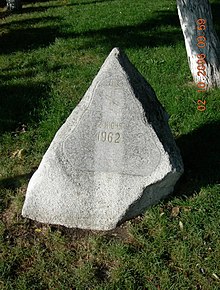You can help expand this article with text translated from the corresponding article in Russian. (November 2020) Click [show] for important translation instructions.
|
| Novocherkassk massacre Новочеркасский расстрел | |
|---|---|
 Tombstone to the victims of the massacre, also known as the "Stone on Blood". The writing reads: "2 June 1962". | |
| Location | Novocherkassk, Rostov Oblast, Russian SFSR, Soviet Union |
| Date | 2 June 1962 |
Attack type | Shooting |
| Weapons | Sniper rifles, machine guns, APCs, cars, tanks |
| Deaths | 26 (officially) |
| Perpetrators | Soviet Army, KGB |
| Motive | Quelling protests |
The Novocherkassk massacre (Russian: Новочеркасский расстрел, romanized: Novocherkasskiy rasstrel) was a massacre carried out by the Soviet army and KGB against unarmed civilians who were rallying on 2 June 1962 in the Soviet city of Novocherkassk.[1][2] A few weeks prior to the massacre, workers at the Electro Locomotive Novocherkassk plant (NEVZ) had organized a peaceful labor strike. Government forces killed 26 people, according to the official account, in the massacre.[3]
On January 1, 1962, the wages at the NEVZ were lowered by 30–35%.[3] At the same time, the production quotas which were set up for workers as a part of the Soviet Union's planned economy were raised. These events also coincided with a sharp nationwide increase in the prices of dairy and meat products (up to 35% according to one account), raising them above the budget of many workers.[3][a][5] Protesters gathered near the city's central administrative building did not disperse when ordered by the surrounding Soviet troops, who then opened fire,[6] killing 26 and wounding 87, including children.[7]
Arrests, show trials and cover-ups ensued: about 240 were arrested, seven people were convicted of various crimes such as "mass disorder" and sentenced to death and hundreds of others were imprisoned for up to 15 years (though the prison terms of some were later reduced).[8] News of the events never appeared in the state-controlled press and the Soviet government continued to conceal it until April 27, 1991; however, it was described in a few underground samizdat publications.[9][10]: 390 [11] The 26 dead were secretly buried by KGB operatives in graves which were not disclosed to relatives and friends until June 2, 1994, when almost all bodies were discovered and reburied at the official memorial.
In 1992, shortly after the dissolution of the Soviet Union, the events were investigated by the Chief Military Prosecutor's Office. The major suspects among the highest-ranking Soviet officials such as Nikita Khrushchev, Anastas Mikoyan, Frol Kozlov and several others who were deemed responsible for the massacre had died by the time of the investigation.[12][13] Each year, the massacre is commemorated on its anniversary by a group of surviving participants. Some of the victims of the massacre were symbolically compensated for their illegal imprisonment and deaths. In 1990, a museum was dedicated to the victims of the massacre next to the square where it took place.
| Eastern Bloc |
|---|
 |
- ^ 1961: Novocherkassk Massacre Archived 2011-03-03 at the Wayback Machine
- ^ a b Cite error: The named reference
:6was invoked but never defined (see the help page). - ^ a b c Grant, Ted (2017). "The Novocherkassk uprising". Russia : from revolution to counter-revolution (2 ed.). Wellred Books. ISBN 978-1-900007-72-6. OCLC 1014425658.
- ^ Siuda, Piotr (May 2, 1988). The Novocherkassk Tragedy, June 1-3 1962 (Report). "Obschina".
- ^ "Novocherkassk Massacre". Seventeen Moments in Soviet History. 2015-06-19. Retrieved 2019-06-02.
- ^ Siegelbaum, Lewis (19 June 2015). "Novocherkassk Massacre". Seventeen Moments in Soviet History.
Failing to heed a warning from the general in charge of troops stationed in and around the building, the crowd was dispersed by gunfire.
- ^ "Не хватает денег на мясо и колбасу, ешьте пирожки с ливером". Бессмертный барак. 2 June 2016. Retrieved 2016-06-02.
- ^ Taubman, William. Khrushchev: The Man and His Era, First Edition, W. W. Norton & Co., New York. 2003.
- ^ "Massacre in Workers Paradise". Washington Post. 1990-12-18. ISSN 0190-8286. Retrieved 2019-06-02.
- ^ Cite error: The named reference
#kozlov-0was invoked but never defined (see the help page). - ^ ""Приехали, расстреляли, и все": семейные фотографии, память места и опыт государственного насилия в Новочеркасске » ИНТЕЛРОС" [«They arrived and killed, and that's all»: The family photos, memorial places and experience of state committed violence in Novocherkassks]. www.intelros.ru. 2013. Retrieved 2022-06-02.
- ^ Би-би-си, Артем Кречетников; Москва (25 May 2012). "Бойня в Новочеркасске: "Но был один, который не стрелял"". BBC News Русская служба (in Russian). Retrieved 2019-06-02.
В 1992 году Главная военная прокуратура возбудила по факту новочеркасского расстрела уголовное дело против Хрущева, Козлова, Микояна и еще восьми человек, которое было прекращено в связи с их смертью.
- ^ Ростов, АиФ- (2017-06-02). "Новочеркасский расстрел: герои, палачи и жертвы трагедии 1962 года". www.rostov.aif.ru. Retrieved 2019-06-02.
Cite error: There are <ref group=lower-alpha> tags or {{efn}} templates on this page, but the references will not show without a {{reflist|group=lower-alpha}} template or {{notelist}} template (see the help page).